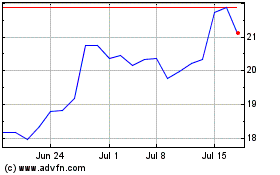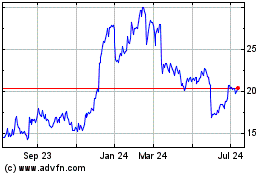Telecoms Consider Fee Hikes as Fierce Price War Plays Out
July 31 2016 - 5:59AM
Dow Jones News
By Thomas Gryta
The wireless price war may have reached detente.
After years of slashing prices, offering stunning promotions and
undercutting each other to grab new subscribers in a market that
has reached near saturation, the four largest U.S. wireless
carriers have reported second-quarter results that suggest prices
have stabilized. Some operators are even talking about how price
rises could be in the future.
Sprint Corp., which has been offering half-off promotions, said
the time might be coming to stop discounting and start increasing
rates. Verizon Communications Inc. already raised prices on its
service plans, while T-Mobile US Inc., which stoked the competitive
fire of recent years, raised prices last year, and now says it is
open to making a similar move going forward. AT&T Inc. hasn't
changed its pricing in almost a year.
"The price war has played itself out," said Angelo Zino, an
equity analyst with S&P Global, noting that switching customers
away from smartphone subsidies has reset the fee structure. "We saw
an interesting couple of years."
For all carriers, the average revenue per user, a metric used to
calculate how much the carriers earn from their subscribers, has
plateaued after dropping steadily since late 2013, according to
data from UBS Group AG. In the second quarter, the metric fell to
$50.20, down from $60.70 in the third quarter of 2013, but only
down slightly from $50.40 in the first quarter, according to UBS
data.
The stabilization of pricing comes at a time when carriers are
facing big investments and slowing revenue growth. The federal
government is running a large auction of wireless airwaves, which
is expected to draw billions of dollars from bidders. Sprint is
investing heavily to upgrade its network.
Other factors have helped drive the user revenue figure lower.
As carriers have moved away from subsidy plans, their service
revenue has dropped because most consumers now finance their
devices with separate monthly payments that aren't counted as part
of the annual per user revenue metric.
But even adjusted for that change, analyst Craig Moffett with
MoffettNathanson estimates that prices were falling 5% a year just
a year ago, but now that decline has significantly slowed.
"They may have even fully stabilized at this point" on a
quarter-to-quarter basis, Mr. Moffett said. "We have been going
through this gradual healing process for the market, where it is
still highly competitive but it is seemingly more rational."
Earlier this week, Sprint reported stronger than expected
customer additions for the latest quarter, and noted that it would
be soon raising prices after a prolonged period of deep
discounting.
The carrier, which has fallen to fourth-largest in the U.S.,
needed to use lower rates to attract customers until its network
improved, CEO Marcelo Claure said Monday. "We're committed to
increasing the average billing per user," Mr. Claure said on a
conference call.
Verizon recently raised its rates by $5 or $10 a month, but
increased the size of its data buckets to offset the higher bills.
Last fall, T-Mobile quietly raised prices on many of its plans and
told Wall Street it was nudging customers away from unlimited data
plans. T-Mobile Chief Executive John Legere said he doesn't feel
pressure to raise prices.
"We've got opportunities when it is seen as value accretive to
our customers to expand price, but the price conversation to us is
not a mandatory lever," Mr. Legere said in an interview. Like
Verizon, T-Mobile's last price rise came with larger data
allotments for customers.
A Verizon spokesman said its price move wasn't an increase, but
rather the higher rates provide "better value" for customers.
Customers remain price sensitive, S&P's Mr. Zino said, and
carriers aren't yet likely to run the risk of raising monthly fees.
Analysts also caution that the coming new iPhone this fall could
spark a fresh round of promotions because upgrade cycles are one of
the few moments when consumers will change carriers.
"The obvious question is whether this endures," Mr. Moffett
said, "or whether we take another leg down when the iPhone 7
arrives."
Write to Thomas Gryta at thomas.gryta@wsj.com
(END) Dow Jones Newswires
July 31, 2016 05:44 ET (09:44 GMT)
Copyright (c) 2016 Dow Jones & Company, Inc.
SentinelOne (NYSE:S)
Historical Stock Chart
From Mar 2024 to Apr 2024

SentinelOne (NYSE:S)
Historical Stock Chart
From Apr 2023 to Apr 2024
